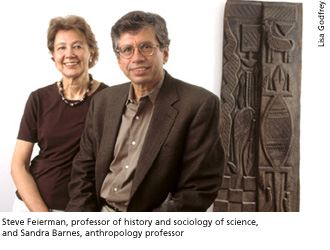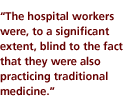
A Family
Affair
Traditional Healing and Modern Medicine in Africa

On March 22, 1960, historian Steve Feierman was reading the New York
Herald inside a Chock Full O’ Nuts coffee shop on Broadway
and 116th Street. He remembers the date because he kept the newspaper
story that changed the course of his career that day. The headline reads,
“Police in South Africa Fire on Natives; 62 Die.” A photo shows
the dead sprawled amid stones that had been cast by anti-apartheid demonstrators
in Sharpeville.
“I came upon this article,” he recalls, “and decided that, if there was an urban uprising, there had to be a social history, but it wasn’t part of the university curriculum.” Feierman was an undergrad at Columbia preparing a senior thesis on European history. “Here was a whole continent with a huge and complex history, and no historians that I knew of were studying it. I just started doing African history on my own, and I’ve been doing it ever since.”
Sandra Barnes, his wife, is an anthropology professor who studies Africa as well. Her introduction was less cerebral. She came down with both feet in West Africa as a Peace Corps volunteer. “Africa is probably one of the most hospitable places in the world,” she says. “There’s a great joie de vivre and an expressive culture that just captures the imagination as soon as you set foot there.”
 The
continent is not only three times the size of the U.S., but it has a vastly
greater variety of cultures among inhabitants who speak nearly a thousand
languages. Feierman is wary about how African customs can appear exotic
to those unfamiliar with the culture, “as if they have nothing to
do with the world we live in.” When he was a young scholar, a traditional
healer in Tanzania once asked how American healers would treat an illness
caused by sorcery.
The
continent is not only three times the size of the U.S., but it has a vastly
greater variety of cultures among inhabitants who speak nearly a thousand
languages. Feierman is wary about how African customs can appear exotic
to those unfamiliar with the culture, “as if they have nothing to
do with the world we live in.” When he was a young scholar, a traditional
healer in Tanzania once asked how American healers would treat an illness
caused by sorcery.
“Well, I don’t know that we deal with that sort of thing,”
Feierman told him. “After all, we don’t have sorcery.”
“What do you mean?” the healer exclaimed. “Do you never
get angry with one another? Do you not have enemies?”
Early in his career, Feierman was part of a team that interviewed patients and caregivers in Ghaambo, a village in northeastern Tanzania. Villagers distinguished between illnesses that “just happened” from those inflicted by the hostility of another. Families often cycled through a series of treatments—from hospital, to therapeutic herbs, to ritual dance, to spirit-possession ceremony—in an attempt to work through uncertainty over a malady’s cause or a healer’s skill or the reliability of received traditions. “What you get is a kind of integrated care by family, neighbors, and friends,” Feierman explains. “They’re providing the health insurance; they’re providing the nursing care; they’re providing the food, and they’re treating doctors and traditional healers as consultants who give them expert advice, which they use to size up what works and what doesn’t.”
Barnes and Feierman are both members of the Africa Health Group, a collection of scholars and practitioners from across Penn’s schools. The group’s cross-disciplinary perspective makes it more effective, says Barnes, a co-founder and co-director. “If you’re not taking account of the social context in which medical problems are being dealt with, your solutions aren’t going to work.”
Bumbuli Hospital near Ghaambo is a case in point. Feierman notes that there is a subtle “grammar of transactions” in how relatives of the sick first engage a healer with kifuka mzighi, “the payment of digging up medicine,” all the way to a voluntary final payment, which celebrates a successful outcome. The money exchanges are not simply recompense for supplies and services. “Among traditional healers,” he reports, “payments define the therapeutic act as embedded in a relationship of reciprocity. In many contexts, it is the reciprocal relationship, created through payment—along with ritual words and actions—that potentiates a medicine.”
Bumbuli Hospital workers, many of them local, had no accepted way of coming to terms with approaches that see medicine as a ritual that binds people together, a treatment that heals the body, and a commodity all at the same time. When the hospital, struggling to remain fiscally viable, increased fees and demanded payment up front, the local, traditional medicine came into conflict with hospital medicine. The policy led villagers to complain that payment without treatment and without family negotiations was kupatapata, “a way to get money,” which implied that staff members were bogus healers.
“The hospital workers were, to a significant extent, blind to the fact that they were also practicing traditional medicine,” says Feierman, and needed to engage villagers in ways that seemed fair and sensible to them.
Governments in Africa are eager to make use of Western-style medicine, Feierman says, and families are usually not reluctant to embrace it as one of several attempts for a cure. “The problem isn’t integration, it’s the disproportion between the size of health issues and the size of resources for dealing with them.” Last year he worked in a major hospital that had no X-ray machine. The year before he saw hospitalized children who, in America, would have been admitted to a critical care unit. Because of the load of more serious illnesses, they were only being seen by doctors every couple of days.
“Poverty produces more ill health,” Barnes observes. “Given the size of the problems and their unsympathetic treatment in the American press, Africa seems daunting. But those of us who have worked there for many years find it vibrant and fascinating.”